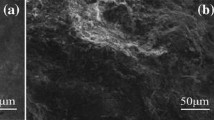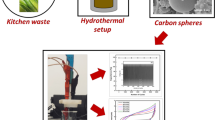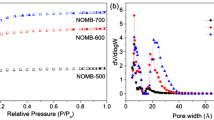Abstract
A porous nanocarbon spheres (PNCSs) were prepared from kitchen waste and successfully used for the metal and oxidant free degradation of azo compounds. The PNCSs obtained by the pyrolysis of onion peel, at 1000 °C, were found to be effective catalysts for the reductive degradation of azo dyes in presence of hydrazine hydrate. The reductive cleavage of azo bonds (–N=N–) was achieved under microwave irradiation. The degradation process was completed in a span of 10–40 min; the process was monitored by ultraviolet–visible spectroscopy. Fourier transform infrared spectroscopy was also used for the illustration of azo degradation. Interestingly, the reductive degradation of azo dyes produced corresponding amines and they were successfully reused for the preparation of fresh azo compounds. The work, therefore, highlights the valorization of largely produced kitchen-wastes to the sustainable PNCSs and it also provides a platform to demonstrate their applicability as highly cost-effective catalysts for bulk scale chemical transformations.
Graphical Abstract













Similar content being viewed by others
References
A. Bratovcic (2019). Different applications of nanomaterials and their impact on the environment. Int. J. Mater. Sci. Eng. 5, 1–7. https://doi.org/10.14445/23948884/IJMSE-V5I1P101.
M. Shafiq, S. Anjum, C. Hano, I. Anjum, and B. H. Abbasi (2020). An overview of the applications of nanomaterials and nanodevices in the food industry. Foods (Basel, Switzerland) 9, 148. https://doi.org/10.3390/foods9020148.
M. Dimitrijevic, N. Karabasil, M. Boskovic, V. Teodorovic, D. Vasilev, V. Djordjevic, N. Kilibarda, and N. Cobanovic (2015). Safety aspects of nanotechnology applications in food packaging. Procedia Food Sci. 5, 57–60. https://doi.org/10.1016/j.profoo.2015.09.015.
P. M. Kopittke, E. Lombi, P. Wang, J. K. Schjoerring, and S. Husted (2019). Nanomaterials as fertilizers for improving plant mineral nutrition and environmental outcomes. Environ. Sci. Nano 6, 3513–3524. https://doi.org/10.1039/C9EN00971J.
S. Kaul, N. Gulati, D. Verma, S. Mukherjee, and U. Nagaich (2018). Role of nanotechnology in cosmeceuticals: A review of recent advances. J. Pharm. 2018, 3420204. https://doi.org/10.1155/2018/3420204.
U. P. M. Ashik, A. Viswan, S. Kudo, and J. Hayashi, Nanomaterials as catalysts, in S. Mohan Bhagyaraj, O. S. Oluwafemi, N. Kalarikkal, and S. B. T. S. Thomas (eds.), Micro Nano Technology (Woodhead Publishing, Sawston, 2018), pp. 45–82.
K. Silas, W. A. W. A. K. Ghani, T. S. Y. Choong, and U. Rashid (2019). Carbonaceous materials modified catalysts for simultaneous SO2/NOx removal from flue gas: A review. Catal. Rev. 61, 134–161. https://doi.org/10.1080/01614940.2018.1482641.
S. Supriya, V. S. Shetti, and G. Hegde (2018). Conjugated systems of porphyrin–carbon nanoallotropes: a review. New J. Chem. 42, 12328–12348. https://doi.org/10.1039/C8NJ02254B.
S. Supriya, G. S. Ananthnag, V. S. Shetti, B. M. Nagaraja, and G. Hegde (2020). Cost-effective bio-derived mesoporous carbon nanoparticles-supported palladium catalyst for nitroarene reduction and Suzuki-Miyaura coupling by microwave approach. Appl. Organomet. Chem. 34, e5384. https://doi.org/10.1002/aoc.5384.
G.L.-M. Léonard, S. L. Pirard, A. Belet, B. Grignard, C. Detrembleur, C. Jérôme, and B. Heinrichs (2019). Optimizing support properties of heterogeneous catalysts for the coupling of carbon dioxide with epoxides. Chem.Eng. J. 371, 719–729. https://doi.org/10.1016/j.cej.2019.04.055.
S. Sarkar, N. T. Ponce, A. Banerjee, R. Bandopadhyay, S. Rajendran, and E. Lichtfouse (2020). Green polymeric nanomaterials for the photocatalytic degradation of dyes: a review. Environ. Chem. Lett. 18, 1569–1580. https://doi.org/10.1007/s10311-020-01021-w.
Y. Sha, I. Mathew, Q. Cui, M. Clay, F. Gao, X. J. Zhang, and Z. Gu (2016). Rapid degradation of azo dye methyl orange using hollow cobalt nanoparticles. Chemosphere 144, 1530–1535. https://doi.org/10.1016/j.chemosphere.2015.10.040.
S. L. Foster, K. Estoque, M. Voecks, N. Rentz, and L. F. Greenlee (2019). Removal of synthetic azo dye using bimetallic nickel-iron nanoparticles. J. Nanomater. 2019, 9807605. https://doi.org/10.1155/2019/9807605.
S. Batool, S. Akib, M. Ahmad, K. S. Balkhair, and M. A. Ashraf (2014). Study of modern nano enhanced techniques for removal of dyes and metals. J. Nanomater. 2014, 864914. https://doi.org/10.1155/2014/864914.
W. Ruan, J. Hu, J. Qi, Y. Hou, C. Zhou, and X. Wei (2019). Removal of dyes from wastewater by nanomaterials: a review. Adv. Mater. Lett. 10, 9–20. https://doi.org/10.5185/amlett.2019.2148.
M. Fatima, R. Farooq, R. W. Lindström, and M. Saeed (2017). A review on biocatalytic decomposition of azo dyes and electrons recovery. J. Mol.Liq. 246, 275–281. https://doi.org/10.1016/j.molliq.2017.09.063.
Ş Gül and Ö. Özcan-Yıldırım (2009). Degradation of reactive red 194 and reactive yellow 145 azo dyes by O3 and H2O2/UV-C processes. Chem. Eng. J. 155, 684–690. https://doi.org/10.1016/j.cej.2009.08.029.
A. Rehorek, M. Tauber, and G. Gübitz (2004). Application of power ultrasound for azo dye degradation. Ultrason. Sonochem. 11, 177–182. https://doi.org/10.1016/j.ultsonch.2004.01.030.
V. K. Gupta, S. Saravanan, S. Agarwal, F. Gracia, M. M. Khan, J. Qin, and R. V. Mangalaraja (2017). Degradation of azo dyes under different wavelengths of UV light with chitosan-SnO2 nanocomposites. J. Mol. Liq. 232, 423–430. https://doi.org/10.1016/j.molliq.2017.02.095.
J. Fan, X. Hu, Z. Xie, K. Zhang, and J. Wang (2012). Photocatalytic degradation of azo dye by novel Bi-based photocatalyst Bi4TaO8I under visible-light irradiation. Chem. Eng. J. 179, 44–51. https://doi.org/10.1016/j.cej.2011.10.029.
M. Cai, J. Su, Y. Zhu, X. Wei, M. Jin, H. Zhang, C. Dong, and Z. Wei (2016). Decolorization of azo dyes Orange G using hydrodynamic cavitation coupled with heterogeneous Fenton process. Ultrason. Sonochem. 28, 302–310. https://doi.org/10.1016/j.ultsonch.2015.08.001.
H. Lv, H. Zhao, T. Cao, L. Qian, Y. Wang, and G. Zhao (2015). Efficient degradation of high concentration azo-dye wastewater by heterogeneous Fenton process with iron-based metal-organic framework. J. Mol. Catal. A Chem. 400, 81–89. https://doi.org/10.1016/j.molcata.2015.02.007.
S. Rojas and P. Horcajada (2020). Metal–organic frameworks for the removal of emerging organic contaminants in water. Chem .Rev. 120, 8378–8415. https://doi.org/10.1021/acs.chemrev.9b00797.
A. Stolz (2001). Basic and applied aspects in the microbial degradation of azo dyes. Appl. Microbiol. Biotechnol. 56, 69–80. https://doi.org/10.1007/s002530100686.
J. H. Ramirez, F. J. Maldonado-Hódar, A. F. Pérez-Cadenas, C. Moreno-Castilla, C. A. Costa, and L. M. Madeira (2007). Azo-dye Orange II degradation by heterogeneous Fenton-like reaction using carbon-Fe catalysts. Appl. Catal. B Environ. 75, 312–323. https://doi.org/10.1016/j.apcatb.2007.05.003.
A. K. Mishra, T. Arockiadoss, and S. Ramaprabhu (2010). Study of removal of azo dye by functionalized multi walled carbon nanotubes. Chem. Eng. J. 162, 1026–1034. https://doi.org/10.1016/j.cej.2010.07.014.
R. A. Pereira, M. F. R. Pereira, M. M. Alves, and L. Pereira (2014). Carbon based materials as novel redox mediators for dye wastewater biodegradation. Appl. Catal. B Environ. 144, 713–720. https://doi.org/10.1016/j.apcatb.2013.07.009.
P. Thirukumaran, R. Atchudan, A. S. Parveen, K. Kalaiarasan, Y. R. Lee, and S.-C. Kim (2019). Fabrication of ZnO nanoparticles adorned nitrogen-doped carbon balls and their application in photodegradation of organic dyes. Sci .Rep. 9, 19509. https://doi.org/10.1038/s41598-019-56109-3.
R. Atchudan, T. N. J. I. Edison, S. Perumal, D. Karthikeyan, and Y. R. Lee (2017). Effective photocatalytic degradation of anthropogenic dyes using graphene oxide grafting titanium dioxide nanoparticles under UV-light irradiation. J. Photochem. Photobiol. A Chem. 333, 92–104. https://doi.org/10.1016/j.jphotochem.2016.10.021.
R. Atchudan, T. N. J. I. Edison, S. Perumal, M. Shanmugam, and Y. R. Lee (2017). Direct solvothermal synthesis of zinc oxide nanoparticle decorated graphene oxide nanocomposite for efficient photodegradation of azo-dyes. J. Photochem. Photobiol. A Chem. 337, 100–111. https://doi.org/10.1016/j.jphotochem.2017.01.021.
J.-M. Wu and W. Wen (2010). Catalyzed degradation of azo dyes under ambient conditions. Environ. Sci. Technol. 44, 9123–9127. https://doi.org/10.1021/es1027234.
P. Satapathy, R. Adiga, M. Kumar, G. Hegde, and S. K. Prasad (2021). Porous nanocarbon particles drive large magnitude and fast photomechanical actuators. J. Nanostruct. Chem.. https://doi.org/10.1007/s40097-021-00414-9.
A. Rastogi, F. P. Pandey, A. S. Parmar, S. Singh, G. Hegde, and R. Manohar (2021). Effect of carbonaceous oil palm leaf quantum dot dispersion in nematic liquid crystal on zeta potential, optical texture and dielectric properties. J. Nanostruct. Chem.. https://doi.org/10.1007/s40097-020-00382-6.
P. Kanagavalli, G. R. Pandey, V. S. Bhat, M. Veerapandian, and G. Hegde (2021). Nitrogenated-carbon nanoelectrocatalyst advertently processed from bio-waste of Allium sativum for oxygen reduction reaction. J. Nanostruct. Chem.. https://doi.org/10.1007/s40097-020-00370-w.
A. John, L. Benny, A. R. Cherian, S. Y. Narahari, A. Varghese, and G. Hegde (2021). Electrochemical sensors using conducting polymer/noble metal nanoparticle nanocomposites for the detection of various analytes: a review. J. Nanostruct. Chem. 11, 1–31. https://doi.org/10.1007/s40097-020-00372-8.
S. Liu, Y. Zhao, B. Zhang, H. Xia, J. Zhou, W. Xie, and H. Li (2018). Nano-micro carbon spheres anchored on porous carbon derived from dual-biomass as high rate performance supercapacitor electrodes. J. Power Sources 381, 116–126. https://doi.org/10.1016/j.jpowsour.2018.02.014.
Y. Liu, L. Pan, T. Chen, X. Xu, T. Lu, Z. Sun, and D. H. C. Chua (2015). Porous carbon spheres via microwave-assisted synthesis for capacitive deionization. Electrochim. Acta 151, 489–496. https://doi.org/10.1016/j.electacta.2014.11.086.
P. Hou, G. Xing, L. Tian, G. Zhang, H. Wang, C. Yu, Y. Li, and Z. Wu (2019). Hollow carbon spheres/graphene hybrid aerogels as high-performance adsorbents for organic pollution. Sep. Purif. Technol. 213, 524–532. https://doi.org/10.1016/j.seppur.2018.12.032.
X.-K. Kong, C.-L. Chen, and Q.-W. Chen (2014). Doped graphene for metal-free catalysis. Chem. Soc. Rev. 43, 2841–2857. https://doi.org/10.1039/C3CS60401B.
A. Primo, V. Parvulescu, and H. Garcia (2017). Graphenes as metal-free catalysts with engineered active sites. J. Phys. Chem. Lett. 8, 264–278. https://doi.org/10.1021/acs.jpclett.6b01996.
T. Asefa (2016). Metal-free and noble metal-free heteroatom-doped nanostructured carbons as prospective sustainable electrocatalysts. Acc. Chem. Res. 49, 1873–1883. https://doi.org/10.1021/acs.accounts.6b00317.
A. Kumar, G. Hegde, S. A. B. A. Manaf, Z. Ngaini, and K. V. Sharma (2014). Catalyst free silica templated porous carbon nanoparticles from bio-waste materials. Chem. Commun. 50, 12702–12705. https://doi.org/10.1039/c4cc04378b.
G. Sriram, S. Supriya, M. Kurkuri, and G. Hegde (2019). Efficient CO2 adsorption using mesoporous carbons from biowastes. Mater. Res. Express 7, 15605. https://doi.org/10.1088/2053-1591/ab5f2c.
G. A. M. Ali, S. Supriya, K. F. Chong, E. R. Shaaban, H. Algarni, T. Maiyalagan, and G. Hegde (2019). Superior supercapacitance behavior of oxygen self-doped carbon nanospheres: a conversion of Allium cepa peel to energy storage system. Biomass Convers. Biorefinery 11, 1311–1323. https://doi.org/10.1007/s13399-019-00520-3.
K. B. Akshaya, V. S. Bhat, A. Varghese, L. George, and G. Hegde (2019). Non-enzymatic electrochemical determination of progesterone using carbon nanospheres from onion peels coated on carbon fiber paper. J. Electrochem. Soc. 166, B1097–B1106. https://doi.org/10.1149/2.0251913jes.
S. Supriya, G. Sriram, Z. Ngaini, C. Kavitha, M. Kurkuri, I. P. De Padova, and G. Hegde (2020). The role of temperature on physical–chemical properties of green synthesized porous carbon nanoparticles. Waste Biomass Valorization 11, 3821–3831. https://doi.org/10.1007/s12649-019-00675-0.
L. Habte, N. Shiferaw, D. Mulatu, T. Thenepalli, R. Chilakala, and J. W. Ahn (2019). Synthesis of nano-calcium oxide from waste eggshell by sol–gel method. Sustain 11, 1–10. https://doi.org/10.3390/su11113196.
X. Luo, X. Song, Y. Cao, L. Song, and X. Bu (2020). Investigation of calcium carbonate synthesized by steamed ammonia liquid waste without use of additives. RSC Adv. 10, 7976–7986. https://doi.org/10.1039/C9RA10460G.
B. N. Sunil, W. S. Yam, and G. Hegde (2019). Photoresponsive behavior of hydrophilic/hydrophobic-based novel azobenzene mesogens: synthesis, characterization and their application in optical storage devices. RSC Adv. 9, 40588–40606. https://doi.org/10.1039/C9RA08211E.
K. R. Lee, K. U. Lee, J. W. Lee, B. T. Ahn, and S. I. Woo (2010). Electrochemical oxygen reduction on nitrogen doped graphene sheets in acid media. Electrochem. Commun. 12, 1052–1055. https://doi.org/10.1016/j.elecom.2010.05.023.
X. Kong, Z. Sun, M. Chen, C. Chen, and Q. Chen (2013). Metal-free catalytic reduction of 4-nitrophenol to 4-aminophenol by N-doped graphene. Energy Environ. Sci. 6, 3260–3266. https://doi.org/10.1039/C3EE40918J.
X. Zhou, P. Wang, Y. Zhang, L. Wang, L. Zhang, L. Zhang, L. Xu, and L. Liu (2017). Biomass based nitrogen-doped structure-tunable versatile porous carbon materials. J. Mater. Chem. A 5, 12958–12968. https://doi.org/10.1039/C7TA02113E.
B. M. Matsagar, R.-X. Yang, S. Dutta, Y. S. Ok, and K.C.-W. Wu (2021). Recent progress in the development of biomass-derived nitrogen-doped porous carbon. J. Mater. Chem. A 9, 3703–3728. https://doi.org/10.1039/D0TA09706C.
Q.-Q. Zhuang, J.-P. Cao, Y. Wu, M. Zhao, X.-Y. Zhao, Y.-P. Zhao, and H.-C. Bai (2021). Heteroatom nitrogen and oxygen co-doped three-dimensional honeycomb porous carbons for methylene blue efficient removal. Appl. Surf. Sci.. https://doi.org/10.1016/j.apsusc.2021.149139.
Acknowledgements
G.H. thanks the Department of Science and Technology, Government of India for providing the project Grant (File Number: SR/NM/NT-1026/2017). Authors also thank TEQIP-III for the support of microwave synthesizer.
Author information
Authors and Affiliations
Corresponding author
Ethics declarations
Conflict of interest
The authors declare that they have no conflict of interest.
Additional information
Publisher's Note
Springer Nature remains neutral with regard to jurisdictional claims in published maps and institutional affiliations.
Rights and permissions
About this article
Cite this article
Supriya, S., Ananthnag, G.S., Maiyalagan, T. et al. Kitchen Waste Derived Porous Nanocarbon Spheres for Metal Free Degradation of Azo Dyes: An Environmental Friendly, Cost Effective Method. J Clust Sci 34, 243–254 (2023). https://doi.org/10.1007/s10876-021-02208-z
Received:
Accepted:
Published:
Issue Date:
DOI: https://doi.org/10.1007/s10876-021-02208-z




